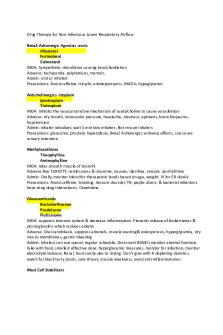Degenerative drugs PDF

| Title | Degenerative drugs |
|---|---|
| Author | May Ambon |
| Course | pathology |
| Institution | Alfaisal University |
| Pages | 5 |
| File Size | 362.2 KB |
| File Type | |
| Total Downloads | 94 |
| Total Views | 148 |
Summary
summary table of drugs used in degenerative diseases...
Description
Drugs in Degenerative Brain Disease Parkinson Disease main pathogenesis is lack of dopamine, causing an imbalance between dopamine and Ach. Can be genetic (early age), idiopathic (parkinson’s Disease), Drug induced Parkinson’s (by some antiepileptic drugs) -
All treatments are asymptomatic (relieving symptoms)
When to start a treatment? Because it has huge side effects affecting huge %. So, it depends on couple of factors: - Degree of symptoms interfering with daily life. - Dominant hand or not (if its in the dominant he wont be able to use it properly for daily activity) - Bradykinesia or gait disturbance (increases risks to falls and injury) - Patients Preference 4 main drug classes for Symptomatic relief 1. Levo-dopa highest efficacy, highest motor complication (dyskinesia), most frequent dosing. 2. Dopamine Agonism Intermediate efficacy, lower risk of motor complication, highest behavioral/mental complications 3. MAO-B inhibitors modest efficacy, well tolerated 4. Amantadine modest efficacy, well tolerated
Drugs for Parkinson’s Disease Class Levodopa (Dopamine Precursor)
Drugs Carbidopa/Levodopa Both drugs are marketed together with different strength (Sinemet) 10/100, 25/100, 25/250mg
Mechanism A direct precursor of dopamine in the brain 1.crosses BBB via L-amino transport system 2. in Basal Ganglia, converted to DA by Dopadecarboxylase -Carbidopa prevents levodopa from being converted into dopamine in peripheral circulation
Pharmacokinetics Absorption: rapid from sm. Intestine. Food delays its absorption. - Its metabolites get excreted by kidney. - ½ life is 1-3hr Always administered with carbidopa -extends to 6-8hrs with carbidopa -decrease its metobilism in periphery Distribution: -used in combo with carbidopa is to be given 3to4 times daily. Controlled/sustained drugs (slowly release drugs in body over long time to sustain therapeutic window) isn’t recommended initially. Why? 1. are less completely absorbed – symptomatic relief takes longer to achieve. 2. don’t allow proper assessment of patient’s response.
Administration Oral = most common. Other preparation: PD patients may have autonomic instability reduced gastric motility absorption probems Continuous intestinal gel infusion: -A tube (bypass any barrier that suppress the effect) is inserted to duodenum or jejunum. - machine infuses a dose every 16 hours avoided when sleep. -disadvantages: - being introduced to surgical intervention. - Possibility of peritonitis. - Gel formulation won’t allow B12 and B6 absorption leading to neurological deficit. Inhaled L-Dopa, used with oral tablets but doesn’t replace it. No need for carbidopa cz we don’t deal with GI. Disintegrating Tablets (dissolved/absorbed in buccal mocosa)
Effects Adverse effects GIT: nausea, anorexia, and vomiting in 80% (Ldopa alone), combination > Alzheimer’s
It has modest benefits on cognition, but not on behavior or daily activities.
Effect GIT: nausea, vomiting, and diarrhea in 20-305 BRADYCARDIA HYPOTENSION WEIGHTLOSS dizziness...
Similar Free PDFs

Degenerative drugs
- 5 Pages

Herpes drugs, anti cancer drugs
- 6 Pages

Hemostasis drugs
- 5 Pages

Psychotomimetic drugs
- 7 Pages

Controlled Drugs
- 25 Pages

Respirotory Drugs
- 3 Pages

Dopaminergic Drugs
- 2 Pages

Drugs-immmunity
- 19 Pages

Drugs Pregnancy
- 9 Pages

Gastrointestinal drugs
- 3 Pages

Psych Drugs
- 19 Pages

Antiepileptic drugs
- 5 Pages

Antibacterial drugs
- 37 Pages
Popular Institutions
- Tinajero National High School - Annex
- Politeknik Caltex Riau
- Yokohama City University
- SGT University
- University of Al-Qadisiyah
- Divine Word College of Vigan
- Techniek College Rotterdam
- Universidade de Santiago
- Universiti Teknologi MARA Cawangan Johor Kampus Pasir Gudang
- Poltekkes Kemenkes Yogyakarta
- Baguio City National High School
- Colegio san marcos
- preparatoria uno
- Centro de Bachillerato Tecnológico Industrial y de Servicios No. 107
- Dalian Maritime University
- Quang Trung Secondary School
- Colegio Tecnológico en Informática
- Corporación Regional de Educación Superior
- Grupo CEDVA
- Dar Al Uloom University
- Centro de Estudios Preuniversitarios de la Universidad Nacional de Ingeniería
- 上智大学
- Aakash International School, Nuna Majara
- San Felipe Neri Catholic School
- Kang Chiao International School - New Taipei City
- Misamis Occidental National High School
- Institución Educativa Escuela Normal Juan Ladrilleros
- Kolehiyo ng Pantukan
- Batanes State College
- Instituto Continental
- Sekolah Menengah Kejuruan Kesehatan Kaltara (Tarakan)
- Colegio de La Inmaculada Concepcion - Cebu


